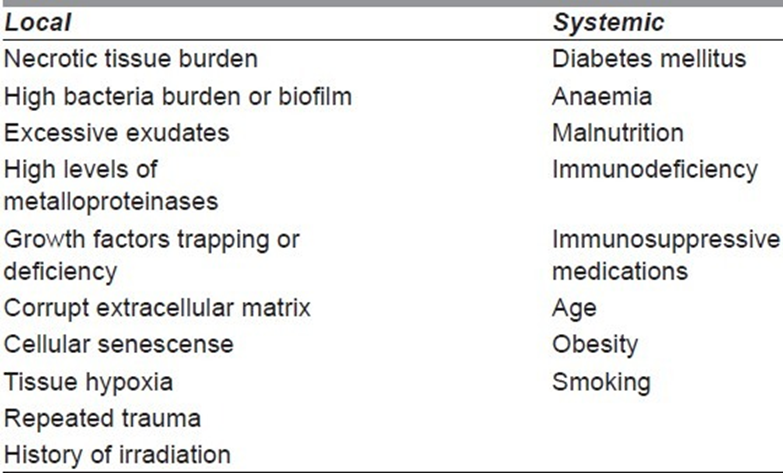A nurse is caring for a client who is scheduled for surgery.
Exhibit 1
Medical History
0800:
Client has a history of malnutrition, hyperlipidemia, and diabetes mellitus.
Mini Nutritional Assessment screening tool score of 7 points (0 to 14 points)
The nurse is reviewing the client's medical record. Which of the following findings places the client at risk for delayed wound healing? Select all that apply
History of diabetes mellitus
Cholesterol level
Prealbumin level
History of hyperlipidemia
Mini Nutritional Assessment screening tool score
History of malnutrition
Correct Answer : A,C,E,F
A. History of diabetes mellitus: This is correct. Diabetes mellitus can lead to delayed wound healing due to various factors, including impaired circulation, neuropathy, and compromised immune function.
B. Cholesterol level: While abnormal cholesterol levels can impact cardiovascular health, they are not directly linked to delayed wound healing unless they are part of a broader metabolic disorder or condition that affects vascular health.
C. Prealbumin level: Prealbumin is a marker of nutritional status. Low prealbumin levels can indicate malnutrition, which is a risk factor for delayed wound healing.
D. History of hyperlipidemia: Hyperlipidemia refers to high levels of fats (lipids) in the blood, such as cholesterol and triglycerides. While hyperlipidemia is associated with cardiovascular risk, it is not a direct risk factor for delayed wound healing unless it is part of a broader metabolic syndrome or condition affecting vascular health.
E. Mini Nutritional Assessment screening tool score: This is correct. The Mini Nutritional Assessment (MNA) screening tool assesses nutritional status, and a low score indicates malnutrition or nutritional deficiencies, which can contribute to delayed wound healing.
F. History of malnutrition: This is correct. Malnutrition, whether due to inadequate intake, absorption issues, or other factors, is a significant risk factor for delayed wound healing as it affects the body's ability to repair tissues and fight infection.

Nursing Test Bank
Naxlex Comprehensive Predictor Exams
Related Questions
Correct Answer is B
Explanation
A. Eyewear: Eyewear, such as goggles or a face shield, should be removed after the mask. Eyewear protects the eyes from exposure to infectious respiratory droplets or aerosols. When removing eyewear, the nurse should handle it by the sides and avoid touching the front surface, which may be contaminated.
B. Gloves: Gloves are the first item to be removed when leaving the client's room. This is because gloves are in direct contact with potentially contaminated surfaces or materials. Removing gloves first helps prevent the spread of pathogens from the gloves to other parts of the PPE or the nurse's skin.
C. Mask: After removing gloves, the nurse should remove the mask next. Masks are worn to protect the respiratory system from inhaling airborne infectious particles. When removing the mask, it's important to handle it by the straps or ties and avoid touching the front surface, which may have been exposed to pathogens.
D. Gown: The gown is the last item to be removed. Gowns provide coverage to protect clothing and skin from contamination. When removing the gown, it's important to do so carefully to avoid contaminating oneself or the surrounding environment.
Correct Answer is B
Explanation
A. Use a trochanter roll:
A trochanter roll is a positioning device placed alongside the hip to prevent external rotation of the hip joint and maintain proper alignment of the lower extremities. While it is important for maintaining proper hip alignment, it does not specifically address preventing plantar flexion contractures.
B. Use foot splints.
Plantar flexion contractures occur when the muscles and tendons in the foot and ankle become shortened, leading to a fixed downward pointing of the foot. Foot splints are devices designed to maintain the foot in a neutral position, preventing the development of contractures by keeping the ankle dorsiflexed. They help stretch the muscles and tendons in the foot and ankle, preventing them from becoming shortened over time.
C. Apply an abduction pillow to the legs:
An abduction pillow is a positioning device used to maintain proper hip alignment and prevent adduction of the hips and knees. While it is essential for preventing hip contractures and maintaining hip alignment, it does not directly address preventing plantar flexion contractures.
D. Prop the feet up:
Elevating the feet may be beneficial for improving circulation and reducing swelling, but it does not specifically address preventing plantar flexion contractures. In fact, prolonged elevation of the feet without proper support may increase the risk of developing contractures by allowing the foot to remain in a plantar flexed position for extended periods.
Whether you are a student looking to ace your exams or a practicing nurse seeking to enhance your expertise , our nursing education contents will empower you with the confidence and competence to make a difference in the lives of patients and become a respected leader in the healthcare field.
Visit Naxlex, invest in your future and unlock endless possibilities with our unparalleled nursing education contents today
Report Wrong Answer on the Current Question
Do you disagree with the answer? If yes, what is your expected answer? Explain.
Kindly be descriptive with the issue you are facing.
